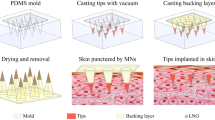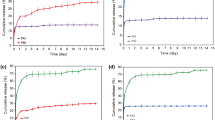Abstract
A thermo-reversible in situ forming implant, based on the combination of Pluronic® F-127 and Pluronic® F-68 with nanostructured lipid carriers (NLC), was formulated with the aim of achieving the sustained release of estradiol valerate (EV). EV-loaded NLC, prepared by the hot high-pressure homogenization technique, presented an entrapment efficiency of 90 ± 2.9 %, a particle size (PS) of 122 ± 11.2 nm, a polydispersity index (PDI) of 0.344 ± 0.07, and a zeta potential (ZP) of − 10.5 ± 1.3 mV. Once obtained, NLC were then included in a thermo-reversible gel (EV-loaded NLC gel), which was characterized by its rheological behavior, gelation temperature, and injectability. The in vitro release tests showed that the EV-loaded NLC gel delayed the release significantly, in comparison with a solution of the drug and with the EV-loaded NLC. The EV-loaded NLC gel and a commercially available suspension containing estradiol were administered parenterally to rabbits. A 16.8-fold greater AUC and a 40-fold higher Cmax were obtained with the EV-loaded NLC gel, compared to the commercial suspension. A rapid initial release of EV in vivo, from the EV-loaded NLC gel, suggests that it is necessary to adjust the ratio of the copolymers or to include in the gel an additive that improves gelation time and gel strength, in order to achieve a sustained release. An interesting observation was that the in vitro profile, which has a three-phase behavior, coincides with what was observed in the in vivo study.

Graphical abstract






Similar content being viewed by others
References
Ameller T, Legrand P, Marsaud V, Renoir J-M. Drug delivery systems for oestrogenic hormones and antagonists: the need for selective targeting in estradiol-dependent cancers. J Steroid Biochem Mol Biol. 2004;92:1–18. https://doi.org/10.1016/j.jsbmb.2004.05.006.
Yoo J-W, Lee C-H. Drug delivery systems for hormone therapy. J Control Release. 2006;112:1–14. https://doi.org/10.1016/j.jconrel.2006.01.021.
Gaffield ME, Curtis KM, Mohllajee AP, Peterson HB. Medical eligibility criteria for new contraceptive methods: combined hormonal patch, combined hormonal vaginal ring and the etonogestrel implant. Contraception. 2006;73:134–44. https://doi.org/10.1016/j.contraception.2005.08.002.
Blanc B, Cravello L, Micheletti M-C, d’Ercole C, Zartarian M. Continuous hormone replacement therapy for menopause combining nomegestrol acetate and gel, patch, or oral estrogen: a comparison of amenorrhea rates. Clin Ther. 1998;20(5):901–12.
Elkasabgy NA, Abdel-Salam FS, Mahmoud AA, Basalious EB, Amer MS, Mostafa AA, et al. Long lasting in situ forming implant loaded with raloxifene HCl: an injectable delivery system for treatment of bone injuries. Int J Pharm. 2019;571:118703. https://doi.org/10.1016/j.ijpharm.2019.118703.
Kamali H, Khodaverdi E, Hadizdeh F, Yazdian-Robati R, Haghbin A, Zohuri G. An in-situ forming implant formulation of naltrexone with minimum initial burst release using mixture of PLGA copolymers and ethyl heptanoate as an additive: in vitro, ex vivo, and in vivo release evaluation. J Drug Deliv Sci Technol. 2018;47:95–105. https://doi.org/10.1016/j.jddst.2018.06.027.
Bode C, Kranz H, Kruszka A, Siepmann F, Siepmann J. In situ forming PLGA implants: how additives affect swelling and drug release. J Drug Deliv Sci Technol. 2019;53:101180.
Dong S, Wang S, Zheng C, Liang W, Huang Y. An in situ-forming, solid lipid/PLGA hybrid implant for long-acting antipsychotics. Soft Matter. 2011;7:5873–8. https://doi.org/10.1039/C1SM05310H.
Jeong B, Sung K, You B. Thermosensitive sol-gel reversible hydrogels. Adv Drug Deliv Rev. 2002;54(1):37–51. https://doi.org/10.1016/S0169-409X(01)00242-3.
Escobar-Chávez JJ, López-Cervantes M, Naik A, Kalia YN, Quintanar-Guerrero D, Ganem-Quintanar A. Applications of thermos-reversible Pluronic F-127 gels in pharmaceutical formulations. J Pharm Pharmaceut Sci. 2006;9:339–58.
Nie S, Wendy Hsiao WL, Pan W, Yang Z. Thermoreversible Pluronic® F127-based hydrogel containing liposomes for the controlled delivery of paclitaxel: in vitro drug release, cell cytotoxicity, and uptake studies. Int J Nanomedicine. 2011;6:151–66. https://doi.org/10.2147/IJN.S15057.
Dumortier G, Grossiord JL, Agnely F, Chaumeil JC. A review of poloxamer 407 pharmaceutical and pharmacological characteristics. Pharm Res. 2006;23:2709–28.
Din F, Mustapha O, Kim DW, Rashid R, Park JH, Choi JY, et al. Novel dual-reverse thermosensitive solid lipid nanoparticle-loaded hydrogel for rectal administration of flurbiprofen with improved bioavailability and reduced initial burst effect. Eur J Pharm Biopharm. 2015;94:64–72. https://doi.org/10.1016/j.ejpb.2015.04.019.
Pitorre M, Gondé H, Haury C, Messous M, Poilane J, Boudaud D, et al. Recent advances in nanocarrier-loaded gels: Which drug delivery technologies against which diseases? J Control Release. 2017;266:140–55. https://doi.org/10.1016/j.jconrel.2017.09.031.
Giuliano E, Paolino D, Fresta M, Cosco D. Drug-loaded biocompatible nanocarriers embedded in poloxamer 407 hydrogels as therapeutic formulations. Medicines. 2019;6:7. https://doi.org/10.3390/medicines6010007.
Müller RH, Petersen RD, Hommons A, Pardeike J. Nanostructured lipid carriers (NLC) in cosmetic dermal products. Adv Drug Deliv Rev. 2007;59(6):522–30. https://doi.org/10.1016/j.addr.2007.04.012.
Pardeike J, Hommoss A, Müller RH. Lipid nanoparticles (SLN, NLC) in cosmetic and pharmaceutical dermal products. Int J Pharm. 2009;366:170–84.
Tapeinos C, Battaglini M, Ciofani G. Advances in the design of solid lipid nanoparticles and nanostructured lipid carriers for targeting brain diseases. J Control Release. 2017;264:306–32. https://doi.org/10.1016/j.jconrel.2017.08.033.
Yilmaz B, Kadioglu Y. Determination of 17 β-estradiol in pharmaceutical preparation by UV spectrophotometry and high performance liquid chromatography methods. Arab J Chem. 2017;10(1):S1422–8. https://doi.org/10.1016/j.arabjc.2013.04.018.
Schmolka IR. Artificial skin I. preparation and properties of Pluronic F-127 gels for treatment of burns. J Biomed Mater Res. 1972;6(6):571–82. https://doi.org/10.1002/jbm.820060609.
Wissing SA, Kayser O, Mûller RH. Solid lipid nanoparticles for parenteral drug delivery. Adv Drug Deliv Rev. 2004;56(9):1257–72. https://doi.org/10.1016/j.addr.2003.12.002.
Shah R, Eldridge D, Palombo E, Harding I. Optimization and stability assessment of solid lipid nanoparticles using particle size and zeta. J Phys Sci. 2014;25(1):59–75 ISSN: 1675-3402.
Malvern Instruments Ltd. (2004). Zetasizer Nano Series. User Manual. United Kingdom.
ACOFARMA. (n.d.), Security file. Review date 2, 12, 2016. http://www.acofarma.com/admin/uploads/descarga/15986212812e7f9ed43f9114bfee18c189e8fbcd574f/main/files/Estradiol%20valerato.pdf
Rowe RC, Sheskey PJ, Quinn ME. Handbook of Pharmaceutical Excipients. 6th ed. London: Pharmaceutical Press; 2009. ISBN 978 0 85369 792 3
Khateb KA, Ozhmukhametova EK, Mussin MN, Seilkhanov SK, Rakhypbekov TK, Lau WM, et al. In situ gelling systems based on Pluronic F127/Pluronic F68 formulations for ocular drug delivery. Int J Pharm. 2016;502(1–2):70–9. https://doi.org/10.1016/j.ijpharm.2016.02.027.
Shi Y, Zhang X, Li J, Wang Z, Cheng S, Chen L, et al. Preparation and pharmacokinetics of an injectable thermosensitive hydrogel of diminazene aceturate. J Drug Deliv Sci Technol. 2013;23(6):531–6. https://doi.org/10.1016/S1773-2247(13)50081-5.
Berteau C, Felipe-Santos O, Wang T, Rojas HE, Granger C, Schwarzenbach F. Evaluation of the impact of viscosity, injection volume, and injection flow rate on subcutaneous injection tolerance. Med Devices Evid Res. 2015;8:473–84. https://doi.org/10.2147/MDER.S91019.
Cilurzo F, Selmin F, Minghetti P, Adami M, Bertoni E, Lauria S, et al. Injectability evaluation: an open issue. AAPS Pharm Sci Tech. 2011;12(2):604–9. https://doi.org/10.1208/s12249-011-9625-y.
Dimer FA, Pohlmann AR, Guterres SS. Characterization of rheology and release profiles of olanzapine-loaded lipid-Core Nanocapsules in Thermosensitive hydrogel. J Nanosci Nanotechnol. 2013;13:8144–53. https://doi.org/10.1166/jnn.2013.7933.
Akkari ACS, Boava Papini JZ, Grcia GK, Dias Franco MKK, Cavalcanti LP, Gasperini A, et al. Poloxamer 407/188 binary thermosensitive hydrogels as delivery systems for infiltrative local anesthesia: Physico-chemical characterization and pharmacological evaluation. Mater Sci Eng C. 2016;68:299–307. https://doi.org/10.1016/j.msec.2016.05.088.
Shen M, Xu YY, Sun Y, Han BS, Duan YR. Preparation of a thermosensitivegel composed of a mPEG-PLGA-PLL-cRGD nanodrug delivery system for pancreatic tumor therapy. ACS Appl Mater Interfaces. 2015;7(37):20530–7. https://doi.org/10.1021/acsami.5b06043.
Funding
The authors are grateful for the financial support provided by CONACyT (Mexico), PIAPI/UNAM (Ref. 1803), and PAPIIT/UNAM (Ref. IN226119). Likewise, they want to thank Dr. Gabriel Araujo-Silva for their excellent assistance with rabbit work.
Author information
Authors and Affiliations
Corresponding author
Ethics declarations
Conflict of interest
The authors declare that they have no conflict of interest.
Ethical standards
The experiments comply with the current laws of the country in which they were performed.
Animal studies
“All institutional and national guidelines for the care and use of laboratory animals were followed.”
Additional information
Publisher’s note
Springer Nature remains neutral with regard to jurisdictional claims in published maps and institutional affiliations.
Rights and permissions
About this article
Cite this article
Pineda-Hernández, M.T., Pérez-Urizar, J.T. & Ganem-Rondero, A. Thermo-reversible in situ forming implant with nanostructured lipid carriers (NLC) as a delivery system for the administration of estradiol valerate. Drug Deliv. and Transl. Res. 10, 1393–1402 (2020). https://doi.org/10.1007/s13346-019-00704-4
Published:
Issue Date:
DOI: https://doi.org/10.1007/s13346-019-00704-4




